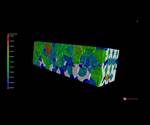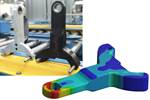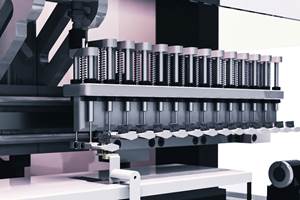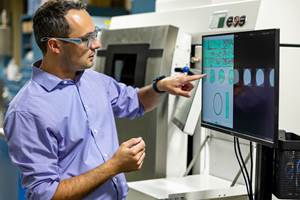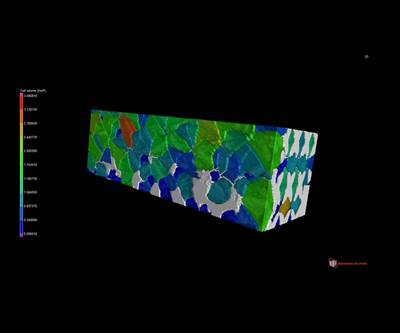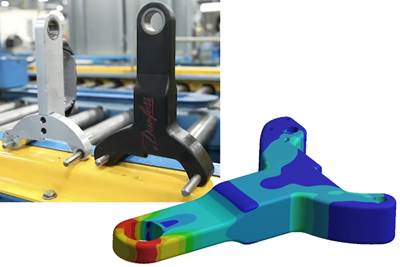Video: Scanning for Fast Model Capture and Validation of AM Parts
3D printing offers a fast way to obtain a part. Can developing the printable file and validating the printed part be done rapidly as well? See fast measurement technology for complex 3D forms I found at IMTS.
At the International Manufacturing Technology Show (IMTS), I searched for developments outside of the show’s additive manufacturing area that have implications for AM. I found examples in Hexagon’s booth. The company showed rapid geometric scanning technology. Its Absolute Arm offers the chance to capture and develop a 3D printable model from an existing object in practically seconds — for example, to 3D print a replacement from an existing part. Another fast and easy-to-use metrology system for larger parts, the company’s Marvel Scan, employs a handheld unit that tracks reference markers on the walls or ceiling around the scan. The system offers a way to validate the form of large complex parts made via AM, and at IMTS, Hexagon was using it to scan a Czinger 21C automobile built on an additive manufactured chassis. I discuss both systems in this video.
Transcript
Additive manufacturing offers a short-lead-time way to make a part. What about capturing the model data? What about validating the part? Can these steps be done quickly?
I am at IMTS, the International Manufacturing Technology Show in Chicago. This is Hexagon’s booth at the show. Hexagon, measurement technology expert. This is the Absolute Arm non-contact scanner capable of capturing model data from a physical object very quickly: 1.2 million points per second scan speed. It handles differences in reflectivity with its SHINE technology: Systematic High Intelligence Noise Elimination.
All that together creates this fast, intuitive way to get model data. One user not only does without physical inventory of spare parts, but now does without digital inventory, too. Instead of using a library of CAD files, scanning parts as they’re needed is the fastest way to get model data. That is getting the model data. What about validating the parts, particularly large additive parts, particularly made from metal? Additive manufacturing offers a way to get a near-net-shape metal part, but can we confirm that it wasn’t distorted as a result of the additive process? Can we get that validation?
This is Hexagon’s Marvel Scan system. One of its features is this extra camera sticking out at a right angle. And because of that extra camera, just as an accidental side effect of the manual scanning that camera tracks with these location markers that are placed in the environment around the scan. Every marker a little bit different, and it allows the scanner to know precisely its position and accurately compile a complex geometric scan. Here it’s being used to scan this Czinger automobile with a chassis made from large laser powder bed fusion parts. A very intuitive measurement system for validating large assemblies, large components like this, low cost as well. One of the system components is the handheld scanner. But as for the location markers, they can be placed on the walls and ceiling by the user themselves.
Related Content
Profilometry-Based Indentation Plastometry (PIP) as an Alternative to Standard Tensile Testing
UK-based Plastometrex offers a benchtop testing device utilizing PIP to quickly and easily analyze the yield strength, tensile strength and uniform elongation of samples and even printed parts. The solution is particularly useful for additive manufacturing.
Read MoreMedical Molder Relies on 3D Printing to Speed Development of Inspection Fixtures
Medical molder Medbio uses FFF and SLA 3D printers in designing (and sometimes producing) its inspection fixtures.
Read MoreDimensionics Density Offers Automated Density Determination for AM-Produced Parts
Formnext 2023: Dimensionics Density’s automatic density determination technology provides automated, accurate and repeatable density determinations for additive manufacturing production.
Read MoreInspection Method to Increase Confidence in Laser Powder Bed Fusion
Researchers developed a machine learning framework for identifying flaws in 3D printed products using sensor data gathered simultaneously with production, saving time and money while maintaining comparable accuracy to traditional post-inspection. The approach, developed in partnership with aerospace and defense company RTX, utilizes a machine learning algorithm trained on CT scans to identify flaws in printed products.
Read MoreRead Next
CT Scanning Reveals What Isn’t There in 3D Printed Parts
3D Engineering Solutions offers CT scanning as a powerful nondestructive testing (NDT) solution for inspection. For 3D printed parts, sometimes revealing the space inside can be just as valuable as mapping what was printed.
Read MoreCollaboration Develops Image-Based Workflow for 3D-Printed Part Validation
A team from Synopsys, North Star Imaging and ANSYS developed a process using 3D imaging, processing and CAE to examine the performance of as-manufactured components.
Read MoreWorkflow Validates 3D-Printed Composite Part Performance
A new workflow connecting 3D printing data with finite element analysis (FEA) enables simulations of fiber-reinforced 3D-printed parts that can predict mechanical and structural performance.
Read More

